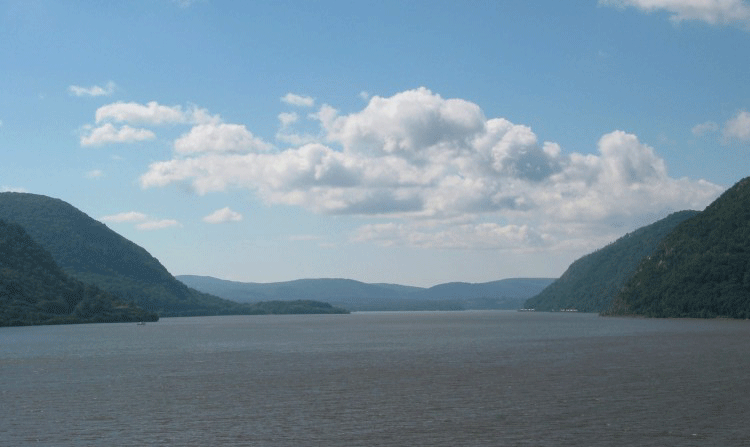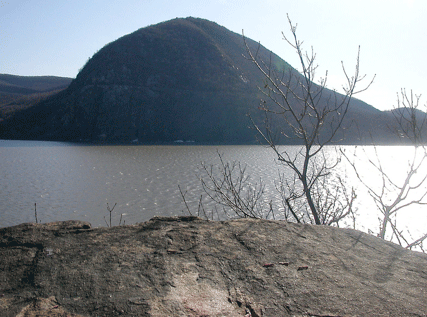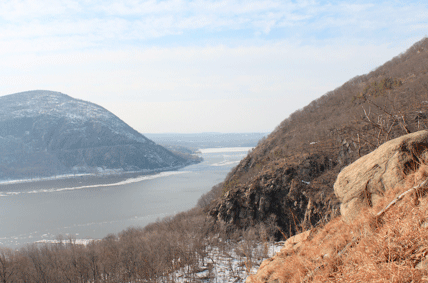Storm King
Air Date: Week of January 3, 2014

Storm King Mountain on the Hudson River. (New York State Department of Environmental Conservation.)
Nearly half a century ago, a remarkable battle over plans to build an electricity pumping station on the Hudson River launched a new branch of the law - environmental law. The facility was planned for Storm King, an iconic mountain known as the gateway to the Hudson Highlands. Producer Jim Metzner recounts the epic story.
Transcript
CURWOOD: It's Living on Earth - I'm Steve Curwood. It all began back in 1963 - when the utility company, Consolidated Edison, announced plans to build a power plant facility on the iconic Storm King Mountain to supply New York's growing energy needs.
What it launched was a full-scale environmental battle to save this gateway to the Hudson Highlands, so treasured and so often painted by artists - think Thomas Cole and Frederick Church.
The campaigners drew on the tactics the NAACP developed for the civil rights movement, and helped launch a whole branch of environmental law. "Storm over the Mountain" presents this epic history. It's part of The Sound and Story Project, mixed and narrated by Jim Metzner.
METZNER: Consolidated Edison was the major energy company serving the New York metropolitan area. In April 1963, they proposed a drawing of the new state-of-the-art plant. ConEd boasted that the plant would satisfy all of New York city’s growing energy needs. But instead, something happened that nobody could have predicted.
[MUSIC]
METZNER: ConEd applied to the federal power commission to build a plant. ConEd, in those days, was as much a part of the industry as the utility companies they were supposed to regulate. So much so that when the chairman of ConEd announced the project he said, “no difficulties are anticipated.” Besides, ConEd was proposing a plant on the Hudson, a river whose pollution was legendary…
[NEWS CLIP: “Here’s Johnny!” But seriously, pollution on the Hudson is really bad! I saw a fisherman the other day, he turned his back for a minute and his worm made a break for it! (laughter)]
DUNWELL: Slaughterhouses dumping chicken parts into the river and blood and guts!
METZNER: Fran Dunwell, Coordinator of the Hudson River Estuary Program, grew up on the river.
DUNWELL: Communities were dumping raw sewage into the Hudson. Industries were dumping industrial chemicals. It was just an industrial canal!
METZNER: Powerplants along the Hudson were not new. ConEd’s nuclear plant was just 38 miles north of New York City. But this would be the first hydro-electric pump storage for the facility.
DUNWELL: So, the idea for the power plant was that they would pump river water up the mountain to a reservoir at the top.

Storm King Mountain. (Photo: Schezar)
METZNER: That’s 8 billion gallons up a two-mile long tunnel 40-feet in diameter.
[SOUNDS OF WATER]
DUNWELL: They would pump it up at night, when there was low demand for electricity, and they would release it from the mountaintop reservoir, down through turbines, back to the river during the day, during peak demand.
METZNER: Those 8 billion gallons of water would sit in the mountaintop reservoir, functioning like a huge storage battery. Then the water would be let loose, surging through the tunnel, generating electricity for New York City.
[WATER SOUNDS]
[MUSIC FROM ELECTRIC AD]
DUNWELL: Everybody went electric, right? In the 50s and 60s, everybody’s buying electric appliances, everybody’s heating their house… this is all basically happening during the day. Then at night, everybody goes to sleep- they turn off the dryer, they turn on the dishwasher, and there’s a low electric demand.
METZNER: It would take more energy to pump the water up the hill than the facility would actually produce, but it worked because they pumped the water up at night when their energy costs were low. And, then, they released the water during the day when demands for energy were high, and they could charge more. You have to admit, it was ingenious.
DUNWELL: No question about it, it was the wave of the future, that’s what everybody was doing… if you wanted to be top of your game in electric power, that’s what you would propose! Here you had this big river full of water, mountains on both sides, just the right height, just the right size…

Storm King Mountain on New York’s Hudson River (Photo: Joseph B)
METZNER: The mountain was Storm King, 3,050 feet high, about 50 miles north of New York City, and it stands like a sentinel guarding the entrance to the Hudson Highlands and some of the most celebrated scenery in the world.
DUNWELL: It was a mountain that had been painted by the Hudson River School of painters, it was where George Washington had fought major battles to win the Revolutionary War, it was a mountain that had incredible significance and that was the mountain that ConEd chose for a power plant.
METZNER: So, in May 1963, ConEd proudly announced in its annual report their plans to build the largest of its kind, state-of-the-art pump storage facility. They also published an image…
[MUSIC]
METZNER: Betsy Pew was a Hudson Valley resident and early grassroots organizer:
PEW: And then everyone stepped back and said: “Good heavens! What is this?”
DUNWELL: …They were aghast. You know, it was… how could you scar Storm King mountain?
PEW: They just took the whole side off the mountain, and people were shocked.
DUNWELL: There was no going back from that.
PEW: The published it with all great pride.
DUNWELL: When people saw this they said: We can’t let this happen.
METZNER: The beloved mountain looked like a set for a science fiction movie, a huge chunk was carved out of its side to house the power plant with a transformer and switch yard in plain view from the river.
DUNWELL: So, a handful of people got together and said: We have to form a coalition of people to fight this.
METZNER: They called themselves the Scenic Hudson Preservation Conference. A group of 12 diverse people who had in common their passion for the river’s diverse history and beauty.
DUNWELL: And, they realized that ConEd was going to have to get a license from the Federal Power Commission, and that would be the only avenue they might have to raise legal issues and fight the project.
METZNER: And so, Scenic Hudson challenged ConEd’s request for a license. The Federal Power Commission or FPC agreed that the scenic value of the Hudson was great, the public’s need for electric power, however, was greater. In 1964, ConEd’s plan to build an electric power plant on the face of Storm King mountain were approved. And a license was granted.
But the case had also caught the attention of Bob Boyle, a writer from Sports Illustrated and an avid fisherman. Bob had explored every nook and cranny of the Hudson and knew that the polluted river was still home to millions of fish that fed the entire east coast fishery. Bob was passionate about the Hudson and he liked a good fight.
[MUSIC]
METZNER: During the FPC hearings, ConEd expert Dr. Alfred Promutter (sp?) guaranteed that there would be no impact on fish eggs and that the spawning grounds for striped bass were much further up the river. He also claimed that no study had been done on the Hudson River fishery since 1936. But, Bob Boyle obtained a copy of thescientific paper written on the Hudson written in the 50s, and so tracked down the authors of this paper…
BOYLE: I said: I have this paper that you did, in which you found that striped bass spawn right in the vicinity of Storm King mountain. He said, that’s right. I said, well… Dr. Alfred Promutter… do you know him? He said: No, he hired us! He was in charge of the survey! I said… oh ho ho!
METZNER: The fact that Storm King mountain was the location of a striped bass spawning ground wasn’t the only thing that ConEd’s expert witness got wrong. He also knew that pumping eggs, larvae, and young fish up a mountain and then shooting them down through a whirl of turbine blades would devastate the fish population.
BOYLE: How would you like it if I said… I’m going to shoot you up in an elevator at 100 miles per hour and I’m going to shoot you down again, and I don’t know how it’s going to stop on the first floor. That’s the essence of what was going on with the fish!
METZNER: Dr. Promutter had estimated that only 3.6 percent of the fish would be killed. But he left out one thing- the Hudson is a tidal river.
BOYLE: What’s critical about this is that if you had striped bass eggs in the Storm King area, they just don’t go back the entrance where the water would be sucked up to Storm King once, they’d go past it 10 times. And so, instead of the phony formula that the state and ConEd concocted that said that 3.6 percent of the fish could be killed, it was 36 percent.
METZNER: To support this claim, someone had taken photos of massive fish kills at ConEd’s Indian Point power plant down the river… photos that mysteriously disappeared. Feeling like a character in a spy novel, Bob Boyle tracked down the photos from two men associated with the conservation department.
BOYLE: I said: How do you happen to have the pictures? They said, well, you know, our superiors came to us and they want the pictures you have- so they took the pictures, and then they came back a month later and they said: We want any duplicates you have. So we gave them the duplicates. I said… well, how do you have this? They said: They didn’t ask about triplicates!
METZNER: The case had also caught the public’s attention. The growing threat of urbanization was changing the American landscape. Rachel Carson’s book Silent Spring exposed the danger of pollution. A belief in the power of the common person to organize and fight large corporations was fueling massive demonstrations…
[MUSIC]
METZNER: Scenic Hudson grew from a small group of concerned citizens to an organization with members form all over the country and the world. They organized protests with letter campaigns, but the main fight remained on the legal battlefield. They hired a prominent law firm to appeal the decision to license the plant. Albert K. Butsel was one of the attorneys assigned to the case.
BUTSEL: I would describe myself at that point as a very freshman, bright and first-year associate.
METZNER: The case was heard in October of 1965. ConEd argued that Scenic Hudson did not have the right to sue, it lacked what in legal terms is called Standing. In order to initiate a lawsuit, you have to have some sort of economic interest.
BUTSEL: You can’t just be a citizen who cares about it- you have to have some kind of legal interest. And, historically, legal interest has been associated with property ownership.
METZNER: Well, Sceneic Hudson was a group of citizens without any financial interest in power plants or the mountain. Nevertheless, they persisted and asked the FPC to demand that ConEd do a better job at reviewing alternative ways to provide power to New York City, and investigate further the threat to the Hudson’s fish.
BUTSEL: And, when the argument was over, I thought we had a 25 percent chance.
METZNER: While Scenic Hudson waited for the court’s decision, something unexpected happened:
[NEWS ALERT: MASSIVE POWER FAILURE IN THE EAST]
BUTSEL: Then on November the 9th, the lights went out in New York, it was the great black out of 1965, and within a day or two ConEdison had put out advertisements into the paper apologizing for the blackout saying that if they had had the Storm King project, they never would have had the blackout. So, from our optimism, we moved to pessimism.
METZNER: Then on December 22, 1965, Al Butsel got a call from a New York Times reporter. For the first time in history, the court had reversed an FPC decision to license a power plant.
[CREEPY LAUGHTER, MUSIC]
BOYLE: I was thrilled to win a case of this importance. Made me feel like I was a contributor!
METZNER: The court agreed with Scenic Hudson that the beauty and historic significance of Storm King had to be considered. The FPC was obligated to thoroughly evaluate all the evidence, including the potential danger to fish, and alternative ways to provide New York City with electricity.
BUTSEL: And, it remanded the case to the Federal Power Commission for further hearing, saying that the preservation of Storm King Mountain, it’s scenic beauty and historic sites, must be regarded as a basic concern.
METZNER: And the courts said that even though Scenic Hudson had no economic or property interests, it did have standing, it had the right to sue.
BUTSEL: It essentially opened the federal courts, and later the state courts, to litigation by environmental groups that had a connection.
METZNER: Well, this was big, a major turning point. It was no longer just about the money. Scenic beauty and wildlife were given protection right alongside business and commerce. It opened up an entirely new way for groups and private citizens to fight development happening in their own backyard. The National Environmental Policy Act was published four years later- modern environmental law was born. Pick up a newspaper any day of the week and it’s likely you can still see the impact of this case. But, Storm King and the Hudson River were not saved.
Even as citizen groups across the country began to use the law to protect scenic beauty and natural resources, the threat to Storm King Mountain and the Hudson River remained. It would take 16 more years of court proceedings and Congressional investigations before the battle was over. Then, finally on December 19th, 1980, representatives from 11 environmental, government and utility groups signed what later became known as the Hudson River Peace Treaty.
[MUSIC: Song about the Hudson River.]
METZNER: In the end, each side gave up something. ConEd abandoned the Storm King project completely and donated the 500 acre site as a park. Environmental groups reduced the steps that ConEd needed to take at its existing power plants on the Hudson to protect the striped bass, but the battle was over. The Hudson River once more gave birth to a new era in America’s history: Citizen groups that formed in response to the Storm King case continue today… Scenic Hudson, River Keeper, the Clearwater Sloop, and the Hudson River Foundation, all guard the river well…
And, although, much still needs to happen to clean up the Hudson, everyday groups across the country depend upon the precedence set by the 1965 case Scenic Hudson vs. the Federal Power Commission. The nation and the Hudson River have won.
DUNWELL: So, I personally taken my kids swimming in the Hudson River and I have gone swimming in the Hudson myself without fear. That’s a huge transformation from what the river was in my childhood.
[MUSIC CONTINUES: Pete Seeger “My Dirty Stream (The Hudson River Song) from God Bless The Grass (Sony Music 1966).]
CURWOOD: Storm over the Mountain come to us from the Sound and Story Project. It was mixed and narrated by Jim Metzner, and produced and edited by Eileen McAdam.
Living on Earth wants to hear from you!
Living on Earth
62 Calef Highway, Suite 212
Lee, NH 03861
Telephone: 617-287-4121
E-mail: comments@loe.org
Newsletter [Click here]
Donate to Living on Earth!
Living on Earth is an independent media program and relies entirely on contributions from listeners and institutions supporting public service. Please donate now to preserve an independent environmental voice.
NewsletterLiving on Earth offers a weekly delivery of the show's rundown to your mailbox. Sign up for our newsletter today!
 Sailors For The Sea: Be the change you want to sea.
Sailors For The Sea: Be the change you want to sea.
 The Grantham Foundation for the Protection of the Environment: Committed to protecting and improving the health of the global environment.
The Grantham Foundation for the Protection of the Environment: Committed to protecting and improving the health of the global environment.
 Contribute to Living on Earth and receive, as our gift to you, an archival print of one of Mark Seth Lender's extraordinary wildlife photographs. Follow the link to see Mark's current collection of photographs.
Contribute to Living on Earth and receive, as our gift to you, an archival print of one of Mark Seth Lender's extraordinary wildlife photographs. Follow the link to see Mark's current collection of photographs.
 Buy a signed copy of Mark Seth Lender's book Smeagull the Seagull & support Living on Earth
Buy a signed copy of Mark Seth Lender's book Smeagull the Seagull & support Living on Earth

